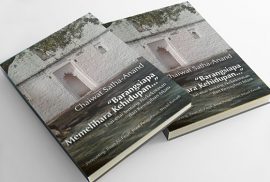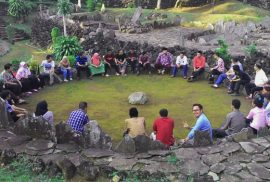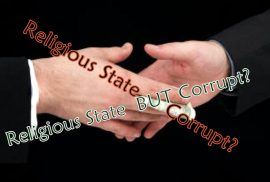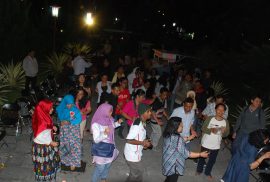Fardan Mahmudatul Imamah | CRCS | SPK

Diskriminasi terhadap masyarakat adat, penghayat, dan penganut kepercayaan hingga saat ini masih berlangsung di Indonesia. Meskipun demikian, Sunda Wiwitan sebagai salah satu agama lokal Sunda terus memperjuangkan hak-haknya sebagai warganegara. Masyarakat Sunda Wiwitan tidak hanya melakukan upaya demi terpenuhinya hak-hak sipil mereka, tetapi juga—bersama komunitas lain di sekitarnya—melawan eksploitasi sumber panas bumi di Gunung Ciremai oleh PT. Chevron Geothermal Indonesia. Dua hal tersebut menjadi tema utama diskusi peserta Sekolah Pengelolaan Keragaman (SPK) VII dengan masyarakat Sunda Wiwitan Cigugur, Kuningan, Jawa Barat, Sabtu 28 November 2015.
Pangeran Djati Kusumah, pimpinan masyarakat Sunda Wiwitan, mengatakan banyak orang yang tidak mengerti dan tidak mengetahui Sunda Wiwitan, termasuk keterlibatan mereka dalam perjuangan kemerdekaan Republik Indonesia. Bagi masyarakat Sunda Wiwitan, adat karuhun Sunda Wiwitan adalah ajaran leluhur Sunda yang menuntun kesadaran spiritual manusia Sunda terhadap kekuatan energi dalam semesta di luar dirinya selaku manusia; sadar pada hukum kepastian-Nya, teguh pada janji menjaga cara ciri manusia dan cara ciri bangsa. Kesadaran itulah yang mendorong mereka untuk terlibat aktif dalam perjuangan kemerdekaan Republik Indonesia di masa penjajahan serta perjuangan menentang eksploitasi sumber panas bumi di masa kemerdekaan ini.

Dalam kesempatan itu pula, Dewi Kanti, salah seorang putri Pangeran Djati Kusumah, menjelaskan masalah diskriminasi terhadap masyarakat Sunda Wiwitan sejak Zaman Belanda. Pada masa pendudukan Belanda, penganut Sunda Wiwitan diisukan sebagai komunitas api atau sempalan Islam, sehingga muncul pertentangan dari pesantren-pesantren. Pangeran Sadewa Alibassa atau dikenal Pengaren Madrais, pimpinan Sunda Wiwitan saat itu, sempat dipenjarakan dengan tuduhan memeras masyarakat dan dianggap gila, sehingga pada tahun 1901–1908 dibuang ke Boven Digul.
Selanjutnya, diskriminasi terkait administrasi sipil dimulai pada masa penjajahan Jepang, dengan berdirinya Shumubu yang saat ini menjadi Kantor Urusan Agama (KUA). Saat itu, masyarakat Sunda Wiwitan tidak dapat melakukan pencatatan pernikahan mereka secara legal karena tidak mengikuti ajaran Islam. Akibatnya, pernikahan masyarakat Sunda Wiwitan mendapatkan stigma “pernikahan liar.” Di masa kemerdekaan, posisi masyarakat Sunda Wiwitan semakin sulit. Pemerintah melalui Badan Koordinasi Pengawasan Aliran dan Kepercayaan (Bakorpakem) yang dibentuk pada 1961, membatasi ritual dan kepercayaan masyarakat Sunda Wiwitan. Oleh karena itu, pada 1964, Pangeran Tedja Buana—putra Pangeran Madrais—menginstruksikan untuk memilih agama dengan simbol “berteduh di bawah cemara putih” guna menyelamatkan komunitasnya dari stigma perkawinan liar.”Sebagian masyarakat Sunda Wiwitan memilih masuk agama Katolik dan Kristen, dan sebagian kecil lainnya masuk ke Islam.
Namun pada 1981, kebijakan Pangeran Tedja Buana tersebut terkendala oleh Misi Gereja Katolik kepada sesepuh adat. Saat itu, acara gereja tidak mengakomodasi tradisi. Pangeran Djati Kusumah, pimpinan Sunda Wiwitan selanjutnya, menyatakan keluar dari Katolik yang kemudian diikuti masyarakat Sunda Wiwitan lainnya. Akibatnya, melalui Bakorpakem, negara melarang segala kegiatan tradisi Sunda Wiwitan, di antaranya Upacara Seren Taun—Syukuran Masyarakat Agraris—selama 17 tahun, dari 1982 hingga 1999.

Dengan berbagai upaya dan peluang untuk terus mempertahankan kepercayaan mereka, masyarakat Sunda Wiwitan membentuk paguyuban dan mendaftarkannya di Kementerian Pendidikan dan Kebudayaan. Meskipun demikian, hal itu tak banyak membantu mengatasi kesulitan administrasi sipil terhadap masyarakat Sunda Wiwitan. Pada proses pembuatan KTP penganut Sunda Wiwitan dianggap tidak beragama, dan kolom agama pun dikosongkan. Selain itu, dalam pembuatan akta kelahiran anak, hanya pihak ibu yang disebutkan, sedangkan bapak ditulis secara administratif sebagai ayah angkat. Siswa penganut Sunda Wiwitan harus menerima ajaran agama lain di sekolah dan sebagian diminta untuk mengikuti kegiatan-kegiatan agama lain. Kesulitan administrasi tersebut berimplikasi pada hak-hak sipil lainnya, seperti pendidikan, pekerjaan dan politik.
Dewi Kanti juga mengatakan, masyarakat Sunda Wiwitan berupaya untuk tetap berkarya dalam menjaga keutuhan tradisi—antara lain melalui produksi ukiran akar dan kayu khas Sunda, batik Sunda, tarian dan lagu-lagu Sunda, serta arsitektur bangunan dengan simbol-simbol Sunda Wiwitan. Selain itu, pihaknya juga berusaha untuk mendokumentasikan praktik pelanggaran konstitusi yang dilakukan oleh aparatur negara terhadap masyarakat Sunda Wiwitan. Bagi masyarakat Sunda Wiwitan, Dewi Kanti berusaha untuk terus meningkatkan daya juang komunitas, penyadaran hak konstitusi, serta penyadaran kewajiban selaku masyarakat bela bangsa.
Lebih lanjut, masyarakat Sunda Wiwitan senantiasa terlibat aktif dalam usaha konservasi lingkungan dan menolak eksploitasi sumber daya panas bumi di lereng Gunung Ciremai. Okki Satria, suami Dewi Kanti, menceritakan bahwa usaha yang dilakukan sejak 2014 tersebut, melalui diskusi dan penguatan komunitas, tidak hanya dilakukan masyarakat Sunda Wiwitan, tetapi juga masyarakat sekitarnya, termasuk Ahmadiyah yang berdekatan dengan lokasi tersebut. Unsur masyarakat meliputi tokoh-tokoh masyarakat, pimpinan agama, pemuda, bahkan ibu-ibu ikut turun ke jalan memperjuangkan isu ini. Aksi penolakan tersebut berhasil mendesak Bupati Kuningan untuk berdiskusi dan mendengarkan keberatan mereka atas eksploitasi tersebut.
(Editor: A.S. Sudjatna)

Headline
Azis A. Fahrudin | CRCS | News
The writer is a graduate student of CRCS batch 2014. This article is his response to Chaiwat Satha-Anand’s compilation articles published by PUSAD Paramadina, Jakarta and his lecture at CRCS on October 8, 2015.
T he book by Chaiwat Satha-Anand entitled “Barangsiapa Memelihara Kehidupan…” consists of a number of essays dealing with, as the subtitle of the book suggests, “nonviolence and Islamic imperatives.” The book seeks to propose theological arguments for nonviolent Islam. Many parts of the book are, thus, filled with Quranic verses and stories and quotes cited from the prophetic traditions which, according to Satha-Anand’s interpretation, support the idea of nonviolent Islam. However, the way he constructs theological arguments is not rigorous enough, especially in consideration of the fact that the position of scripture (both the Quran and the hadiths) toward violence and peace is ambiguous and multi-faceted, a position which in turn brings about complexities of interpretation. This article, thus, serves as a response to Satha-Anand’s ideas of nonviolent Islam as explained in the book. It discusses, first, violence in the scripture, both in the Quran and the prophetic traditions, to show the multi-faceted accounts and some difficulties in interpreting them. Second, it draws several points which should be taken into consideration in dealing with that complexity of interpretation—including in showing the ambivalence of the scripture. In the end, it points out that, besides proposing nonviolent interpretations of Islam, the way the perpetrators of violence perceive the surrounding reality they face must be given equal attention in the discussion.
he book by Chaiwat Satha-Anand entitled “Barangsiapa Memelihara Kehidupan…” consists of a number of essays dealing with, as the subtitle of the book suggests, “nonviolence and Islamic imperatives.” The book seeks to propose theological arguments for nonviolent Islam. Many parts of the book are, thus, filled with Quranic verses and stories and quotes cited from the prophetic traditions which, according to Satha-Anand’s interpretation, support the idea of nonviolent Islam. However, the way he constructs theological arguments is not rigorous enough, especially in consideration of the fact that the position of scripture (both the Quran and the hadiths) toward violence and peace is ambiguous and multi-faceted, a position which in turn brings about complexities of interpretation. This article, thus, serves as a response to Satha-Anand’s ideas of nonviolent Islam as explained in the book. It discusses, first, violence in the scripture, both in the Quran and the prophetic traditions, to show the multi-faceted accounts and some difficulties in interpreting them. Second, it draws several points which should be taken into consideration in dealing with that complexity of interpretation—including in showing the ambivalence of the scripture. In the end, it points out that, besides proposing nonviolent interpretations of Islam, the way the perpetrators of violence perceive the surrounding reality they face must be given equal attention in the discussion.
Fardan Mahmudatul Imamah | CRCS | SPK

Jawa Barat adalah provinsi dengan kasus intoleran tertinggi di Indonesia, khususnya selama delapan tahun terakhir. Kasus intoleran tersebut berupa kekerasan terhadap kelompok minoritas seperti Ahmadiyah dan Syiah, penutupan gereja, kampanye anti perbedaan, peraturan daerah yang diskriminatif, serta pelanggaran hak-hak sipil. Hal ini terungkap pada salah satu sesi diskusi acara Sekolah Pengelolaan Keragaman (SPK), Selasa, 24 November 2015. Acara rutin tahunan hasil dari kerja sama Program Studi Lintas Agama dan Budaya (CRCS) UGM dengan Hivos tersebut dihadiri oleh dua puluh enam orang aktivis dan akademisi dari berbagai institusi pendidikan maupun lembaga sosial kemasyarakatan yang berada di Jawa Barat, seperti Fahmina Institut, Gerakan Islam Cinta, Jaringan Kerja Sama antar Umat Beragama (Jakatarub), Values Institut Bandung, Pelita Perdamaian, Peace Generation Indonesa, IPNU, Majelis Khuddamul Ahmadiyah Tasikmalaya, dan Sunda Wiwitan.
Ali Jafar | CRCS | Wednesday Forum
 Many of us know Ammatoans from general perspectives about them. Their traditional ways of life are fascinating. Indeed, if we watch TV programs about ethnicity or similar topic, Ammatoans are usually portrayed as a small community group who “still” believe in “animism” and hold rituals for forest conservation. In some religious programs on Indonesian television, Ammatoans are shown as Muslim who practice “syncretism” because they give offerings to the forest, mountains and lands. Indonesians have a lot of stereotypes about Ammatoans, but who they really are without judgmen? Concerning with these stereotypes of Ammatoans, On Wednesday 16th September, Wednesday Forum of CRCS/ICRS presented Dr Samsul Maarif who had concerned his deep research in Ammatoans and said in otherwise fact.
Many of us know Ammatoans from general perspectives about them. Their traditional ways of life are fascinating. Indeed, if we watch TV programs about ethnicity or similar topic, Ammatoans are usually portrayed as a small community group who “still” believe in “animism” and hold rituals for forest conservation. In some religious programs on Indonesian television, Ammatoans are shown as Muslim who practice “syncretism” because they give offerings to the forest, mountains and lands. Indonesians have a lot of stereotypes about Ammatoans, but who they really are without judgmen? Concerning with these stereotypes of Ammatoans, On Wednesday 16th September, Wednesday Forum of CRCS/ICRS presented Dr Samsul Maarif who had concerned his deep research in Ammatoans and said in otherwise fact.
Farihatul Qamariyah | Thesis Review | CRCS
| Thesis title | : | Understanding the Spirituality of Officials Convicted of Corruption: Case Study of Wirogunan Prison |
| Author | : | Tjong Lio Ie (CRCS, 2013) |
| Indonesia is known as a country which is great in dealing with spirituality and religiosity in the society life experiences. Based on the World Values Survey (2005-2009), Indonesia ranked as the 15th highest in Spiritual Index among 45 countries in the world. Paradoxically, Indonesia is also ranked as a country involved in the listing committed case of corruption. The evidence is Indonesia‘s ranking as 111th out of 180 countries in the world surveyed in 2009 in the release ofannual Corruption Perceptions Index (CPI) by Transparency International (TI). By looking at this case, the stream of initial assumption is that spiritually strong people will never commit an act of corruption. Conversely in the actual fact, the case of Indonesia, however, brings on questions of law-enforcement, ethics, religion, spirituality and their relation in daily activities.
The thesis Understanding the Spirituality of Officials Convicted of Corruptiontakes the case study of three officials convicted of corruption who are currently imprisoned at Wirogunan Prison, Taman Siswa, Yogyakarta. The primary concern of the research is to examine the connection between spirituality and corruption by focusing on the life experiences of three mid-level Indonesian civil servants currently serving prison terms following convictions of moderate-level corruption. This research consequently comes to some critical questions regarding this fact. Why can one of the most spiritual countries in the world also be one of the most corrupt? Do spiritual values have nothing to do with corruption? Is there any spiritual transformation in the most spiritual countries as their Corruption Perceptions Index shows the highest (meaning the worst) in the world? Answering the list of these questions, the author applies a local approach grounded in the experiences of civil servants who face charges of corruption. The author applies a qualitative method and uses a social constructionist approach to have an overview in understanding the discourse of relation between corruption and spirituality. To obtain the data, semi -structured questionnaires and in-depth interviews were used by the author. In deciding on the three corruptors as the respondents, the author focussed on those in managerial positions of as lurah or mid-level civil servants. This position is where the power of the positionmight be abused. Of his three respondents, one is Christian and two of them are Muslim. Before doing the participatory observation and direct interview session, the agreement and disclaimer were made to keep their identitiessecret. To see the connection between spirituality and corruption, the author firstly puts a context of defining spirituality, corruption, meaning, and otherconceptual terms in use in this research. This research uses a survey method of Spirit at Work Scale (SAWS) by Kinjerski&Skrypnekemphasizing at the four distinctive factors of man‘s spirituality: (1) engaging work, (2) sense of community, (3) spiritual connection, and (4) mystical experience. These surveys were further followed with written and oral interviews about both their responses to the categories of the SAWS questionnaire and then about their life stories,covering both their experiences at the time of the acts for which they have been convicted and of dealing with the suffering of imprisonment. Since this research emphasizes its concern on evaluating a meaning, the author uses the tools of spirituality, religion, and psychology as the point of view to examining the case of corruptors and their life. Through the spirituality and religion, men can interpret their life experiences in the context of suffering, death, and transcendence. Finding a meaning is a significant element since it is the way how men can survive and pass the hardship moments. In psychology as an addition, men can find a meaning of their experience on suffering if they look to the future. Therefore, these three points of view in looking at the case of the corruptors and how they deal with their case on suffered situation are very important. In an illustration for the conceptual discussion above, man can bear any sufferings because he is promised an eternal life in heaven by religions. In psychological context, man is required to become selfless if he is in need of psychological health. There is a sense of future expectation in both reward forward. According to AuschwitzFrankl (1963, P.107), man has to become selfless to find meaning in suffering. In relation with this case, committing corruption against selfless mode because it means self-gratification. Self-gratification in Freud’s statement is the main characteristic of id that always competes with super ego to take control of the ego. To some extent, a selfless mode leads man to the way of finding meaning while self-centered one leads man to meaningless life. Hence, both religion (spirituality) and psychology adopt the same mode of selfless to find meaning in life. The position of spirituality is very significant for the corruptors’ life experiences in overcoming their suffered situation. The respondents’ life story and confession have come to a point of examining whether a spirituality is interplayed or not in looking at the case concerned. The findings through the research questions show that there is a kind of strong connection betweenthe need of spirituality in coping suffering in the context of corruptors’ prison experience. Based on the author’s findings in relation with the connection of spirituality and the cases of corruption he makes several arguments. First, all the corruptors as the respondents of this research possessed a strong spirituality when they were the leaders at their office. This answer is obtainedfrom the SAWS survey method from the measurement of some points such as the spirituality, cognitive, interpersonal, spiritual, and mysticaldimensions. Second, the respondents failed to make balanced act in practicing their spirituality at work. This case is due to their ethical and practical consideration which neglect the critical comprehension of the laws. The respondents‘ premise that corruption is basically about enriching oneself is prevalent which shows the great emphasis on togetherness above individuality. To some extent, it is their unthoughtfulness and lack of professionalism which have caused them to be imprisoned as corruptors. Third, spirituality plays a significant role for them to survive the hardship of imprisonment. The three of them even gained spiritual transformation and found meaning from this situation. Last, the suffered situation initiates them to take a repentance as an inward change that is gotten from the idea of solitude. As mentioned before, the respondents’ score of spiritual assessment showed a high score, it helps them to repent without difficulty. In addition, the author emphasizes his notion on the concept of solitude as an important gate to the account of spiritual transformation. He strengthens his assumption by stating that solitude is the answer where people have to face the atmosphereunthoughtfulness produced by modernity. Solitude in its actualization deals with the context of practice in the daily life. The act of solitude can help people to be aware more on what they are doing of their actions. The respondents‘ life experiences demonstrate the importance of going through solitude as the spiritual gate to experience penitentiary and being born twice. Solitude is also the psychological gate for man to become selfless, find meaning in life and get motivated. |
||
Asep Salik | CRCS | News

Kamis, 8 oktober 2015, CRCS melangsungkan rangkaian kegiatan ulang tahunnya yang ke-15. Bertempat di ruang auditorium gedung Sekolah Pascasarjana, rangkaian acara ini diawali dengan kuliah umum “Nurcholish Madjid Memorial Lecture 2015; Understanding Islam and Politics in the Twenty-First Century”, yang menghadirkan Chaiwat Satha-Anand sebagai narasumber utama. Guru besar Ilmu Politik Universitas Thammasat, Thailand, yang juga dikenal sebagai pemikir serta aktivis nirkekerasan agama ini mempresentasikan makalahnya dengan judul The Sacred in The Mirror. Kuliah umum yang berlangsung mulai pukul 09.00 WIB pagi ini diawali dengan pemutaran film profil CRCS dan dilanjutkan dengan beberapa persembahan lagu dari Josskustik, grup band gabungan mahasiswa dan staf CRCS.







